HE&M Products Manager
ver the 55 years that HE&M has manufactured band saws, its team frequently becomes involved in sawing applications where a standard model just won’t do for the task. So the company has built numerous custom saws. This proved challenging but not insurmountable for the design and engineering staff because each of these builds had unique requirements, which made the results all the more rewarding.
In the early 1990s, a facility that had produced plutonium for nuclear ordnance since the 1950s was decommissioned in Colorado. During deconstruction, over 800 structures were demolished and 21 tons of weapons-grade material was removed. The demolition resulted in 1.3 million cubic meters of waste. Much of that waste was compressed into 3-foot cubes and buried.

The buried material later had to be dug up, then properly contained and disposed because of environmental contamination. The compressed cubes contained identifiable objects—a chair leg, a light bulb, a stapler—and had to be chopped into pieces small enough to fit into 55-gallon drums. Because the material was hazardous and radioactive, it could only be processed in a radiation containment facility, isolated within 3-ft.-thick walls. The only access into the work area was a standard-size service door.
A saw that can handle a 3-foot-square block cannot fit through a standard door, so our engineering team designed a machine that could be dissembled by the customer, carried through the door and then reassembled. Incidentally, due to the risk of radiation exposure, the saw operators could only work for a fraction of their eight-hour shift, a mere 30 minutes, due to the risk of radiation poisoning.
Although there was well-documented contamination released from this plant over the years since the Cold War, an article published in a local newspaper on Oct. 3, 2019, stated that after more than 100 samples of soil were taken, the U.S. Fish and Wildlife Service, which oversees the site, determined that contamination levels were no longer a risk to human health.
Another unusual project was for an aluminum producer that provides material to an airframe builder. The manufacturer requires cast aluminum billets that are 9 feet long, 25 inches high, 70 inches wide and weigh 19,600 pounds.
FAA requirements for the airline jet manufacturing industry mandate that the billets must be tested for metallurgical consistency. To accomplish this, the products selected for testing needed to have 1-inch-thick slices removed from each end and from the middle. There is no standard saw that will cut 70 inches across, so HE&M designed and built two saws that could handle the job. After the cutting and documentation is complete, the aluminum company remelts the test pieces. Interestingly, those 25-inch-thick slabs of aluminum are rolled under heat and pressure down to 1/16 inch thick and end up as the skin on large aircraft.
 HE&M saw has earned numerous patents for its designs, and its team will continue to develop innovations to meet customer challenges.
HE&M saw has earned numerous patents for its designs, and its team will continue to develop innovations to meet customer challenges. 
A company that builds recreational vehicles and fifth-wheel trailers needed two saws for a production facility that produces 1,200 chassis per day, each containing many components that had to be cut.
Since they were going to be operated remotely for 24 hours a day, six days a week, the saws needed to be fully automated; robust to handle three 40-foot beams at the same time; and fast to complete the cutting of all three beams in 30 seconds. The production requirements meant that multiple parts had to be cut simultaneously and precisely because other processes using robotics followed the sawing. Square tolerance requirements were 0.10 mm, and overall length was required to be within 2.5 mm, which are rather tight tolerances given the fast process cycle times.

Because very little hands-on activity was to be performed by humans, the entire process was integrated into a computerized, automated system. The saws included time-saving features specific to the client’s needs, such as an automated “end stop” that squared the beams. The end stop was automatically replaced by a cutting block as the sawing sequence began, and an automated conveyor removed the trim cut ends of the beams.
The saws were required to run with an overall equipment effectiveness (OEE) rating of 80 percent. An OEE of 100 percent means only good parts are produced, at the maximum speed, and without interruption. The 80 percent OEE mandate could be matched but the cut times for the three beams needed to be within 30 seconds. The finished equipment met all the requirements, and the customer’s finished parts were well within all of the mandated tolerances.
A metals processor came to HE&M requesting a saw that could split long I-beams into two T-beams, which are widely used in commercial architectural projects. The I-beams contained internal stresses that required torches to be positioned alongside the saw to alleviate the stresses. This allowed the company to split the beams in a way so that the material did not close up and pinch the blade.
These requirements required a solution to be built from scratch, including material-holding solutions. Holding the beams down vertically and from the sides horizontally is a challenge when the part is moving through the stationary saw blade.
HE&M also has manufactured a saw capable of cutting live explosive ordnance for an aerospace and defense company: bombs weighing up to 400 pounds. This saw design project had no room for error. The machine was designed to minimize metal-on-metal contact to lower the risk of setting off the bombs during sawing. Any mistake here would have been catastrophic.
The saw operator was remotely located 400 feet from the equipment, just in case.
Special care was required in designing all fasteners to prevent them from becoming a projectile if explosive material accumulated. If this occurred and a maintenance procedure required component disassembly, a bolt could become a deadly weapon if a wrench made contact. The quality assurance department required all cast components to be X-rayed to ensure inclusions were minimal and to a strict standard to reduce explosive buildup from minuscule particles that were created during cutting. Any pocket that could trap and collect explosive material would essentially be creating a secondary bomb.
All this goes far beyond the 70 different models of production band saw that HE&M Saw has developed for the metalworking industry since 1964. The company has earned numerous patents for its designs, and its team will continue to develop the next innovations to meet customer challenges.